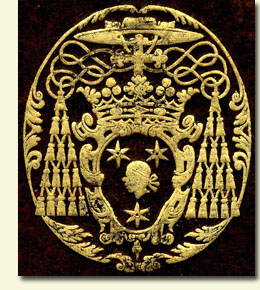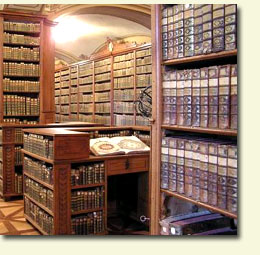|
History of the
Cathedral Library of Kalocsa
The medieval predecessors of the present library were the chapter’s library and
the private library of the archbishops. Beginning with the reign of Saint
Stephen and lasting up to the beginning of the 16th
century, some 300-400 codices and incunabula are thought to have been
collected in Kalocsa. Back then they were used primarily by the professors
and students of the cathedral school, as well as by the priests of the
archdiocese. But in 1526 Archbishop Pál Tomori died in the battle of Mohács
against Suleyman I, and in 1529 the Turkish troops burned the town of
Kalocsa. The members of the chapter were forced to flee, taking with them
whatever valuables and books they could gather. Only two incunabula from the
medieval collection would return to Kalocsa at the beginning of the 20th
century, although a few other books are kept in other libraries scattered
throughout the world. The majority of the medieval collection, however, has
been lost forever, and practically all of it disappeared during the 150
years of Turkish occupation of Hungary.
At the beginning of the 18th century the
reorganization of the chapter became one of the most important objectives of
the archbishops in the task of the reconstruction of the archdiocese. The
members of the Cathedral Chapter, the canons, were the first collaborators
of the archbishop, and whether they were involved with the jobs of archiving
documents, celebrating the liturgy, teaching in the seminary or assisting in
the governance of the diocese, they all needed books. The status of the
collections of the chapter’s library in the 18th century is recorded in some
surviving inventories and catalogs. One of the earliest inventories was made
by Canon György Házy in 1752. It listed 287 works in 602 volumes.
The 18th-century chapter library was used
primarily by the priests of the diocese. The borrowing of books is
registered by receipts next to the inventory book. According to one of these
receipts, in 1776 the professor of rhetoric checked out the eight-languages
dictionary of Ambrosius Calepinus and some works of Seneca and Cicero from
the chapter library.
One of the most outstanding bibliophile archbishops of that period, Ádám
Patachich (1776-1784), bequeathed his private library of 19 thousand volumes
to the archdiocese, as attested by the bequest document dated in 1784. It
mandated that the archbishop’s library and that of the chapter be gathered
into a single collection, and also provided for its maintenance with a
special fund. From that time on, the library has been the common property of
the archbishops and of the Cathedral Chapter of Kalocsa. Its official name
is Bibliotheca Metropolitanae Ecclesiae Colocensis, that is,
Cathedral Library of Kalocsa.
Ádám Patachich was followed in the archiepiscopal seat by László Kollonich
(1787-1817) who shared the interest in collectionism of his predecessor. He
purchased a number of volumes from the libraries of the religious orders
dissolved by Joseph II. His acquisitions often had the intention of
preserving treasures of great importance to cultural history. Starting in
1791, Archbishop Kollonich was assisted in his acquisitions by the historian
István Katona. Thanks to his expertise and knowledge of books, the
collection was enriched during this period with several important volumes on
history, geography and history of sciences.
 At the beginning of the 19th century the
number of volumes in the library was well over 42 thousand. Many people came
to Kalocsa to visit the hall of the Baroque library and its rarities. The
guest book of the library, in use beginning in 1813, recorded the visits of
the Benedictine historians Gergely Czuczor and Flóris Rómer, the minister
Ágoston Trefort, and the painter Mihály Munkácsy with his wife. At the beginning of the 19th century the
number of volumes in the library was well over 42 thousand. Many people came
to Kalocsa to visit the hall of the Baroque library and its rarities. The
guest book of the library, in use beginning in 1813, recorded the visits of
the Benedictine historians Gergely Czuczor and Flóris Rómer, the minister
Ágoston Trefort, and the painter Mihály Munkácsy with his wife.
In more recent times the library’s collection was enlarged principally by
archiepiscopal and canonical bequests. In the second half of the 19th
century the number of readers and borrowers has increased substantially, as
a consequence of the consolidation
of general schooling. The archbishops of
19th and 20th
centuries also enriched the library with the donation of works from their
periods. Among them, the excellent botanist and bibliophile Lajos Haynald
stands out. György Császka collected books of history, genealogy and
heraldry, while Gyula Várossy was a scholar of history and literature who
has left Hungarian, German, French, and English books to the library. The
legacy of József Grősz consists of works of modern pastoral theology and
biblical studies.
The Library today has about 130 thousand volumes, among them about 90 thousand
old prints and more than 800 manuscripts, including 64 medieval codices (11th-16th
centuries). The content of these manuscripts is quite varied, including
bibles, psalteries, regulae of religious orders, sermon
collections as well as medical, juridical, astronomical and historical
works.
The first volume of our CD series presents the most beautifully decorated
manuscript of the library’s collection. This codex was purchased by
Archbishop Ádám Patachich (1776-1784) at an auction in Vienna in 1782, the
same year that he decided to unite his private library with that of the
Chapter of Kalocsa, thus founding the Cathedral Library. |